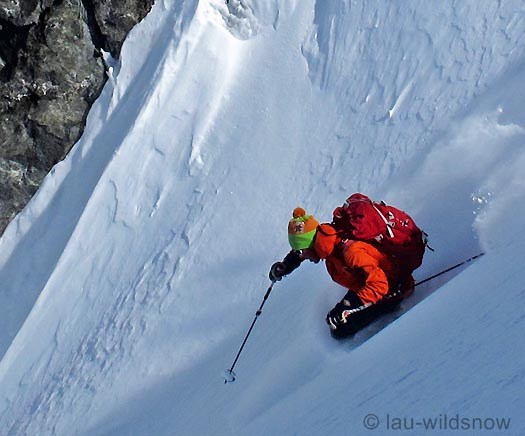
The author testing Scarpa Rush on Decker Glacier, B.C.
Scarpa Rush is a lightweight three buckle backcountry-focused alpine touring boot with tech binding compatibility. Essentially, Rush is the three-buckle version of the four-buckle Maestrale. Since the boots invite so many comparisons, this review of the Rush will draw on previous Wildsnow articles about the Maestrale.
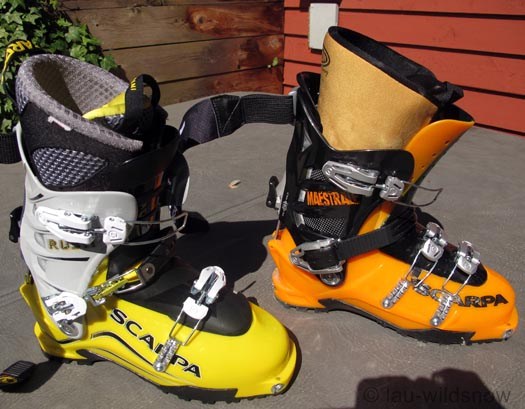
To left is three buckle Scarpa Rush; on the right - the four buckle Scarpa Maestrale. Both terrific shoes for backcountry skiing
Specifications
In the size 27 tested, the Scarpa Rush weighed in at 1440g (actual weight) vs the claimed 1420g; shaving 100g per foot off the already slim Maestrale. Liners are basically the Intuition Pro-tour liner weighing in at 220g. Other boot weights are provided here for comparison.
Rush construction is basically the same as the Maestrale backcountry skiing boot. I won’t repeat all my gushing praise and laborious detail from our previous Maestrale articles, other than to summarize that it is a hybrid design boot with a hinged tongue that lifts to the side ala Maestrale. The tongue is fairly stiff (although some have asked for stiffer), initially finicky to figure out, but marries comfort with performance well. Here are some changes made to the Rush to save weight :
* three buckles instead of four
* instep buckle system is lighter weight.
* all new cuff and foot molds that use the same minimalist design but takes weight-savings a step further (eg shorter cuff, larger ‘windows’)..
* trimmed down ski/walk mechanism to save weight without sacrificing stiffness (weight shaved is internal)
* slightly narrower power strap
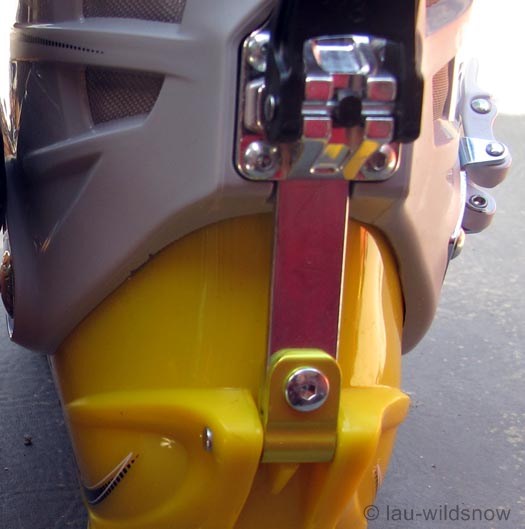
Scarpa Rush trimmed down ski-walk mechanism (all the weight-shavings are internal so not easily visible); Note the anodized piece ostensibly added for additional stiffness, or perhaps to make it easy to remove parts without driving out the lateral pin holding the lower part of the lean-lock bar.
Fit
I have a traditional Asian foot; which means that my forefoot is wider then most and I don’t have any arch to speak of. Unsurprisingly, the Rush fits the same as Maestrale. The Intuition-made liner seems to have ever slightly more volume so I did not have to glue foam on to the plastic shell of the boot to take up space and was quite comfortable with the unmolded liner. In the size 27 tested, boot sole length was 306mm.
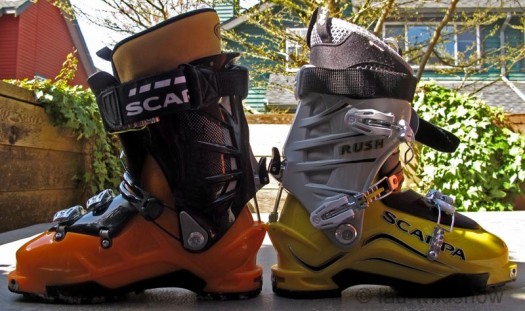
Side by side comparison of Scarpa Maestrale vs Scarpa Rush. The front and rear cuff heights are identical
Performance- up hill and touring
Touring in the Scarpa Rush is like finally experiencing samadhi after 30 years of seemingly fruitless mediation. With so much range of movement (+ 23 to – 15 of cuff range) and the relative light weight, superior touring performance is to be expected. The walk/stride action “feels” smoother than the Maestrale. I admit to not being able to pin down any single reason as the walk mode mechanism is identical in all substantial respects, but as mentioned by commenters here the walk-ski mechanism on some of the current Scarpas appears to bind a bit and thus cause walking resistance. The only change is an anodized piece in the walk mechanism; but the intent is to reduce play, add stiffness and not to add smoothness to the walk mode.
Note that the Scarpa Rush boot walks much better when you slack off all buckles and the power strap. This does mean slower transitions as you will have to go through the extra step of re-tightening buckles and the power strap as you prepare to go downhill.
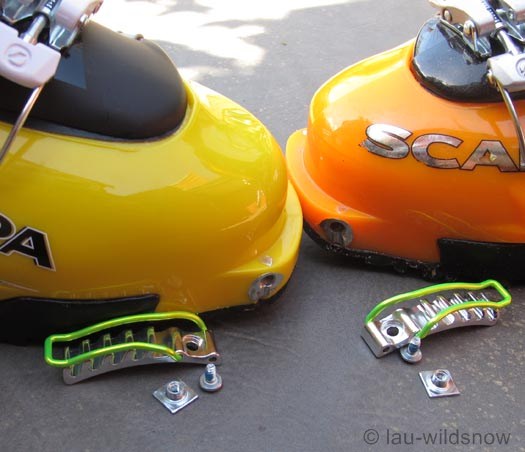
Same fastening hardware in Scarpa Rush as the 2010 - 2011 Maestrale means check your hardware tightness Wildsnow readers!
Performance – downhill
I left the Rush in the 18 degree lean mode while skiing. Rush is not as stiff as the Maestrale and I would rate it as stiff as the Scarpa Spirit 3. It’s certainly not in the same category of downhill performance as heavier, bigger four buckle boots nor should it be expected to be. Having said that, it is more than enough boot for softer snow and if, skied with some restraint, is more than adequate for hardpack.
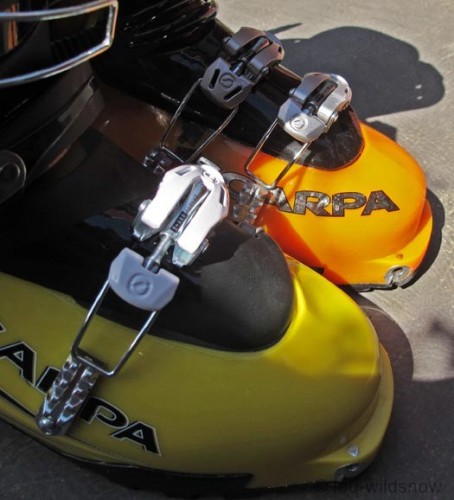
One instep buckle on the Rush replaces two Maestrale forefoot buckles. Folks who are talking about removing one lower buckle on the Maestrale, here you go.
Summary
For my purposes as a touring skier who skis in demanding terrain with high moisture content snow and who isn’t overly blessed with finesse, I find the Scarpa Rush to be a step backward from the Maestrale. It’s good that Scarpa has expanded its product offering; more choice is better! However, in my opinion, the Scarpa Rush would be a good choice for a light skier with superior technique who primarily skis light blower powder snow. Beyond that, it is a tremendous boot from a budget – conscious perspective. Think about the fact that Scarpa has set an exceptionally high bar in creating a line of alpine touring boots that has incredible range of fore-aft motion, lack of mass, fairly decent stiffness and paired it with the superlative Intuition liner; all at a reasonable price. You won’t find it in Scarpa’s marketing material but with the Rush (and Maestrale), Scarpa has again achieved the holy trinity; light, stiff and cheap/inexpensive. Pick three – you can have it all!
The Rush will be shipped this fall in a size range of 25.5- 32. Those with smaller feet might want to try the women’s version of the boot; the Scarpa Blink which comes in a size range of 22.5 – 27.
The Scarpa Rush’s MSRP is USD $ 559, Can $599; thus continuing Scarpa’s seemingly supernatural ability to reverse the trend of increasing prices for touring gear. Perhaps they’ve already achieved samadhi over there in Italy?
Author’s Bias
I weigh 160 lbs and ski mainly in the Coast Mountains of British Columbia in the Vancouver/Whistler/Squamish area. I often travel to the Selkirks, the Monashees and to other touring destinations in B.C. However, my skiing is usually in fairly high moisture-content snow. Accordingly, my preference is for bigger skis and boots. I ski about a 100 days a season. About 70% of my skiing involves some touring. I’ve used a variety of boots, and if you have a question about the Rush and want a comparison to other boots please leave questions in the comments section below.
Shop for Scarpa backcountry skiing boots.
Guest blogger Lee Lau is an avid skier and outdoorsman embarking on many adventures with his loving, and sometimes concerned wife, Sharon. He has over 15 years of experience skiing, ski-touring and dabbles in mountaineering. In the “off-season” he is occasionally found working in his day job as an intellectual property lawyer when he is not mountain biking. As a resident of Vancouver, British Columbia, Lee’s playground extends mainly to Western Canada, including South West B.C. and the Selkirks.
